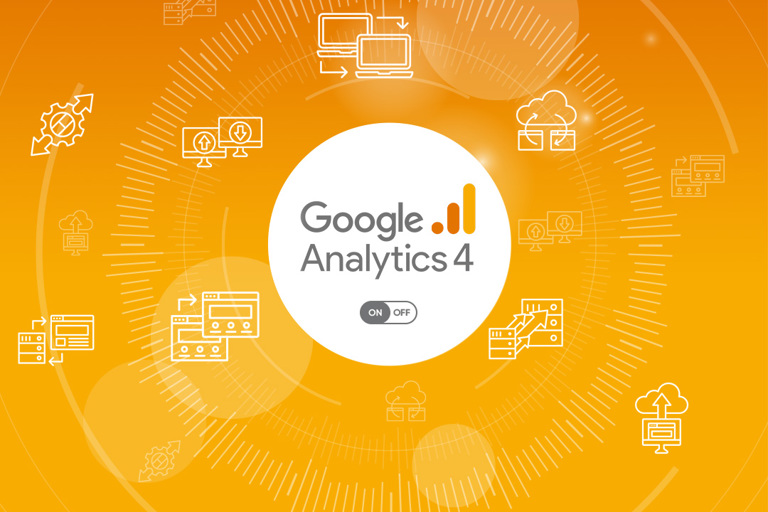GA4: A new era in Web Analytics
As the end of the road approaches for Google Universal Analytics, now is the time to embrace the change and prepare your site for GA4. So, let’s cover off the basics and explore why we should care.
Google announced last month that the ubiquitous Google Universal Analytics (UA) will be phased out and will stop processing data on the 1st of July 2023, to be replaced by Google Analytics V4. At the same time, Google announced that it will only guarantee access to the data collected in UA until January 2024.
This update was not a surprise, as the "new" Google Analytics Version 4 was officially launched back in October 2020. However up until now, the advice was to run both Universal Analytics and Google Analytics 4 (GA4) in parallel, and to treat GA4 as a beta version.
What is GA4?
"GA4 is not a Google Universal Analytics update! It is a new property running on a new platform."
In 2019, Google Launched “App and Web analytics”, designed to measure mobile apps and websites in one place, which previously had not been possible. Despite being welcome by the marketing industry, App and Web didn't get the attention it deserved. Most GA users have a website, not necessarily an App to measure.
In October 2020, Google released GA4, which was simply a renamed “App and Web”. Google encouraged UA users to create GA4 properties for their websites and GA4 became the default property for any new websites (although it is still possible to create Universal Analytics properties).
Why should we care?
“GA4 is more an analysis engine tool as than a reporting platform. The best way to approach GA4 is with questions that needs answers”
Rather than a tool for reporting, for gathering data in an often-passive way, GA4 is active. It’s a powerful engine. It’s about gaining intelligence. But you need to decide how you want to use it. This is where “Explorations” will help you.
Built in reports still exist in GA4, but the platform’s real strength comes from giving power to users to create their own reports from an analysis hub (called “Explorations” in GA4) – These advanced analysis techniques let you build Funnels, uncover user journeys, discover user activities and more. This requires getting your hands dirty and experimenting with the various types of “explorations”. It can be daunting, but the insights you will gain about your customers’ behaviours can be invaluable.
Designed for a world of "imperfect data"
Regulations such as GDPR, the requirement of providing consent tools before recording data and the focus on putting users in control of their data and privacy (and rightly so) means less data is recorded. For a website owner, it becomes more difficult to monitor your marketing effort and website performance.
GA4 is designed as a futureproof solution to these changes by using machine learning and artificial intelligence to “fill the gaps”. It captures the same amount of data currently recorded in UA, however, this “imperfect” data is fed to its algorithm and the modelled data is then sent back to the GA4 user interface. GA4 learns from a website’s own data but also from the data captured from other websites on the platform.
GA4 also offers features that were previously only available to paying subscribers of Universal Analytics 360!
What are the differences between UA and GA4?
GA4 focuses on the users and their journeys
GA4 offers a multitude of templated reports that can be connected to your data (Path analysis, Funnel analysis, User explorer and much more). These can be edited and new reports can be created from scratch. This will give marketers very granular control over the data they want to surface.
Events have changed
Events are triggered in Google Analytics when a user interacts with specified elements on a website, such as watching a video, downloading a PDF or filling out a form.
Some events are automatically collected by GA4 (such as clicking on an outbound links, file downloads, YouTube video complete and many more), while custom events can be set from Google Tag Manager.
Capturing and tracking events can be very helpful to build reports and funnels based on the metrics which matter most, and GA4 allows for up to 25 capture points to define, specific events, up from the three allowed in UA.
Bounce rate is no longer a metric
A favourite amongst marketers to help understand engagement rate, bounce rate has now been replaced with “engagement rate”, defined as a session where the person as spent at least 10 seconds or more on the site, viewed two or more pages or where a conversion event has taken place.
Data deletion feature
GA4 now enables site users to “surgically” delete pieces of data, within the UI. This could be very useful if a website has been targeted by bots during a particular period, or if the website inadvertently collected Personally Identifiable Information. In case of mistakes, the deletion only becomes permanent after seven days.
Deeper audience integration with Google ads
Marketers can now build and maintain audiences lists from their visitors across their website and app. This could be very useful in preventing unnecessary ad spend and preventing retargeting ads annoying customers who have already made a purchase.
Funnels and Path analysis
GA4 provides highly flexible and customisable reporting tools to help brands understand their customers and their journeys. Funnels can help understand if users follow the expected navigation path, whilst Path analysis helps explore the steps users take through the website.
With this information, top performing content can be identified, whilst inefficient, looping or abandoned customer journeys can be improved.
The User Interface
The user interface is brand new, and perhaps less intuitive in terms of build-in reports that many are accustomed to in Universal Analytics. However, GA4 will continue to integrate with Data Studio, and we recommend using this tool for more user-friendly reporting than can be achieved in GA4.
What should you do now?
- Review the role of the website in your marketing strategy, making sure your marketing efforts are supported through data
- Ensure that GA4 is installed and running on your website
- Set the data retention period to 14 months instead of the default two months
- Ensure that Google Search Console is linked to GA4 for reporting on your website’s performance in organic search
- If you use Google Ads, link your account to GA4
- Audit and review the UA events tracked currently on your website and convert them into GA4 events
- Audit and review the UA goals set up on your site and convert them to GA4 KPIs now called conversions
- Export your historical Universal Analytics data as it will disappear at some point
- Set up a Data Studio dashboard to track performance across your website and app
Of course, Dog can help with all of the above, and we are enjoying getting more hands-on experience with GA4 as we transition our clients onto full use of the platform.
If you have any concerns or queries related to this topic, do not hesitate to contact us!
Read more of our insights

Google Analytics 4 Auto Migration: Why You Should Opt Out
Google Analytics 4 is designed to provide more accurate and detailed insights into user behaviour on your website. With just three months to go, Google will attempt to start auto-migrating your Universal Analytics properties to Google Analytics (GA4), but we recommend that you opt-out of this auto-migration, as this isn’t as simple as it seems.
Read more

Google Analytics & GDPR: A Difficult Relationship
Christophe, our Insights and Technical Analytics Manager, explains what’s at stake now that Austria, France and Italy have ruled that Google Analytics is breaching GDPR.
Read more

You need better data: How to turn your website into an intelligence hub
In this article, Insights and Technical Manager, Christophe Goasduff will explore the perspective that a website should serve as a functioning part of a brand’s marketing strategy, a hub of intelligence at the centre of a brand’s marketing ecosystem.
Read more

